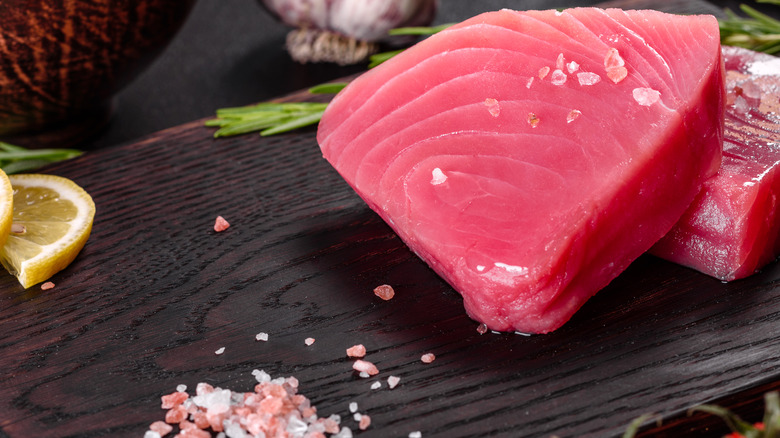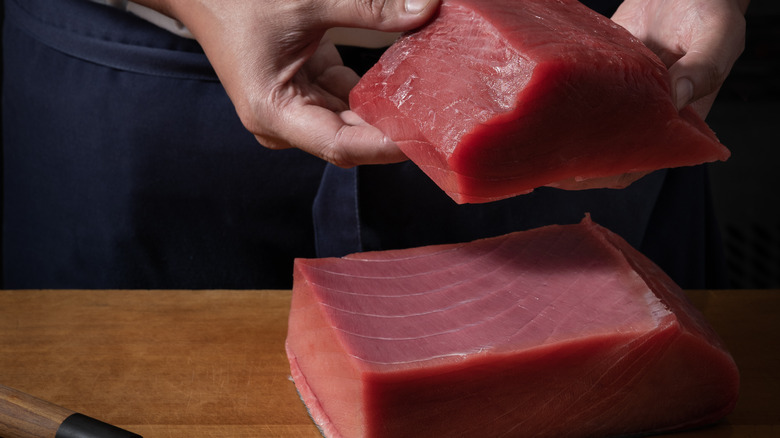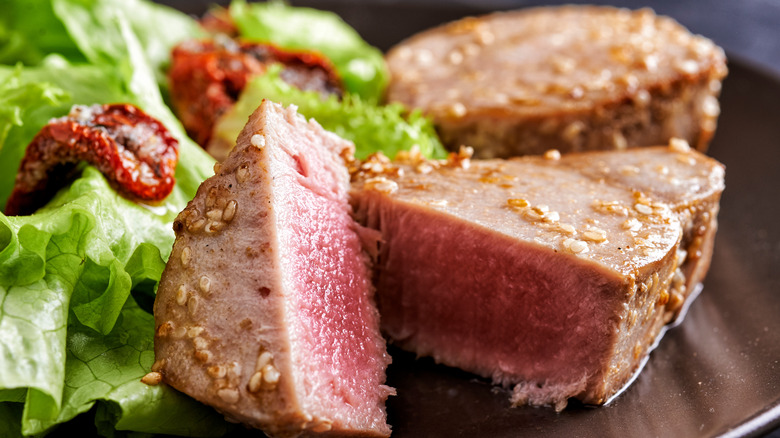The Best Grocery Store For Reliable Tuna Steaks On A Budget
When eaten at home, tuna steaks are often reserved for special occasions or a summer party when seared on the grill. When tuna steaks can run upwards of $15 a pound, and wild-caught can cost even more (via A-Z Animals), it's no wonder that this protein is not often cooked.
There are actually 15 types of tuna that are commonly eaten in the U.S. The more common skipjack and albacore are what shoppers see in cans on the bottom shelves of grocery stores for next to nothing. Thrown into a sandwich or elevated to a pasta dish, canned tuna is an affordable way to feed a family. Tuna of all kinds are packed with nutrients like omega-3, iron, and B vitamins, especially yellowfin (also known as ahi), according to Hawaii Seafood. Ahi tuna steak is sold as sushi-grade and enjoyed raw as sashimi, sushi, or seared as a steak. It is sought after for its pink/red flesh and mildly sweet flavor (via Rarest). Most likely, this is what kind of tuna you are eating in your poké bowl or tuna tataki in restaurants.
What does sushi-grade mean?
When looking to purchase a quality tuna steak, look for fish that is Marine Stewardship Council (MSC)-certified. The MSC is a non-profit organization that works with fisheries all over the world to vet and reward sustainable practices. Make sure the steak isn't slimy and has a uniform color (via The Spruce Eats). Most of us aren't eating raw fish at home, but we certainly feel good when the packaging of the fish we purchase states that it is "sushi-grade." Sushi-grade fish simply means that it has been deemed safe to consume. According to Serious Eats, the U.S. Food and Drug Administration (FDA) does not regulate fish the same way the U.S. Department of Agriculture (USDA) does beef. The label "sushi-grade" just lets people know they are buying quality fish.
Another label consumers often look for when purchasing tuna is if it's wild-caught. Wild-caught means that the fish was caught in its natural habitat eating a wild diet as opposed to being raised on a fish farm and being fed by a farmer. Wild-caught tends to be more expensive because there might be a lower supply in the wild than at a dedicated tuna farm. Both are suitable for consumption, though (via Colorado State University). In the end, with all these options, you may be nervous about buying "cheap" tuna.
You can afford tuna steak for a week-night meal.
Can specialty, high-quality tuna steak be affordable enough for a weeknight meal for the family? The obvious thought for a savvy home chef would be to check at discount grocery stores like Aldi. Surprisingly, Aldi does sell frozen, individually wrapped, sustainable ahi tuna steaks at an equally surprising price, reports The Kitchn. The great thing about frozen is that it can be stored and pulled out when needed as opposed to fresh fish, which needs to be eaten within two days. Most grocery-store "fresh" fish was previously frozen and shouldn't be frozen again (via Los Angeles Times). Aldi is also committed to no synthetic colors, added MSG, or partially hydrogenated oils according to Insider, so you can buy their tuna with more peace of mind. Popular Ask confirms that Aldi's tuna steaks are as high-quality as main-stream grocery stores but at a discounted price. A 12 oz. package of individually wrapped (usually 3) frozen tuna steaks varies per location, but overall Aldi consistently offers their tuna at a significant discount (via Aisle of Shame).
If you're still uncomfortable buying tuna steaks at Aldi, their "twice as nice" guarantee should bring you some comfort. If you are not 100% satisfied, Aldi will not only replace your product, but refund your money (via Aldi). A break from the traditional meat and potatoes weeknight meal may have you running to the store for a tuna treat on a Tuesday night.


